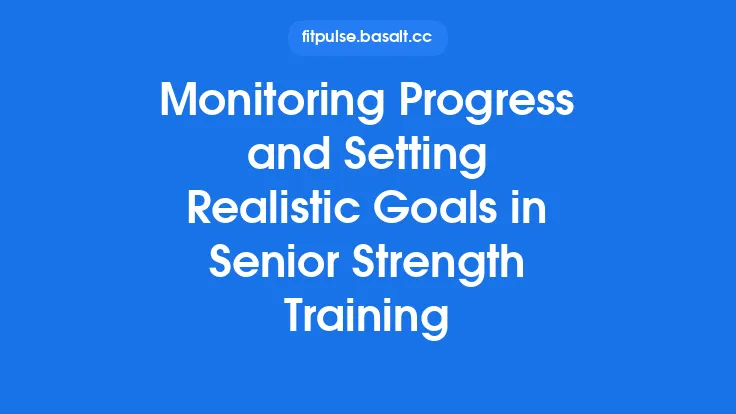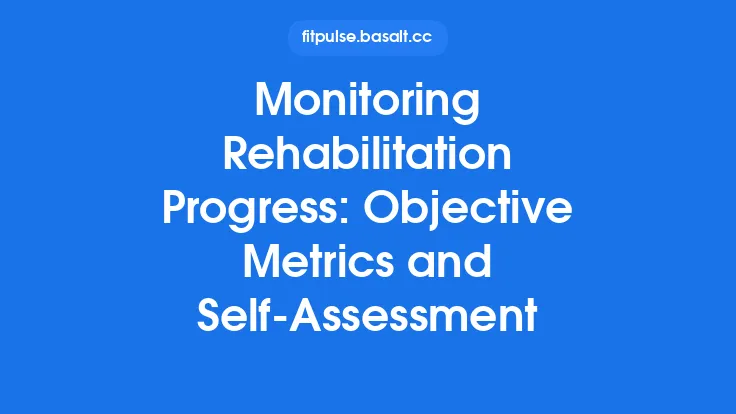In today’s hyper‑connected world, the ability to see concrete evidence of your fitness journey is a powerful catalyst for lasting motivation. Mobile apps have evolved far beyond simple step counters; they now serve as dynamic dashboards that translate raw data into meaningful narratives about your health, performance, and progress. By consistently logging workouts, body measurements, and other health markers, you create a personal data archive that can be mined for insights, celebrated for milestones, and used to fine‑tune future training. This continuous feedback loop helps bridge the gap between short‑term effort and long‑term results, turning abstract goals into tangible achievements.
Understanding the Role of Progress Monitoring
Monitoring progress isn’t just about bragging rights; it’s a scientifically backed method to reinforce behavior change. When you see measurable improvement—whether it’s a faster 5 km run, a higher squat weight, or a lower resting heart rate—your brain releases dopamine, the neurotransmitter associated with reward. This neurochemical response strengthens the habit loop of cue → routine → reward, making it more likely you’ll stick with your regimen. Mobile apps amplify this effect by providing real‑time visual cues (charts, graphs, streak counters) that keep the reward visible even on days when the workout feels tough.
Core Metrics Worth Tracking Over Time
While every individual’s goals differ, certain data points consistently prove valuable for long‑term monitoring:
| Metric | Why It Matters | Typical Frequency |
|---|---|---|
| Workout Volume (sets × reps × weight) | Indicates overall training load and helps prevent overtraining | Every session |
| Cardiovascular Performance (pace, VO₂ max estimate, heart‑rate zones) | Tracks aerobic capacity and recovery efficiency | Every cardio session |
| Body Composition (weight, body‑fat % via bio‑impedance or calipers) | Reflects changes in muscle vs. fat, guiding nutrition and training adjustments | Weekly or bi‑weekly |
| Mobility & Flexibility Scores (range‑of‑motion tests) | Prevents injury and improves movement quality | Monthly |
| Sleep Quality (duration, deep‑sleep % from integrated sensors) | Directly influences recovery and performance | Nightly |
| Subjective Measures (RPE, mood, energy levels) | Provides context for objective data, highlighting stressors or fatigue | Per session |
By consistently logging these metrics, you build a multidimensional picture of your health that goes beyond the single‑dimensional “weight‑loss” narrative.
Setting Realistic, Data‑Driven Milestones
A common pitfall is setting goals that are either too vague (“get fit”) or overly ambitious (“lose 20 lb in a month”). Mobile apps can help you break down long‑term aspirations into SMART milestones—Specific, Measurable, Achievable, Relevant, Time‑bound. For example:
- Baseline Assessment – Use the app’s built‑in test (e.g., 5 km time trial, max push‑ups) to establish a starting point.
- Short‑Term Target – Aim for a 5 % improvement in that metric over the next four weeks.
- Intermediate Goal – Add a new performance marker (e.g., increase squat load by 10 lb) after eight weeks.
- Long‑Term Vision – Combine multiple intermediate goals into a comprehensive yearly plan.
The app’s analytics engine can automatically calculate the required weekly progression rate, alert you if you’re falling behind, and suggest adjustments to keep the trajectory realistic.
Leveraging Visualizations and Trend Analysis
Human brains are wired to recognize patterns. A well‑designed app turns raw numbers into visual stories:
- Line Graphs for tracking weight, heart‑rate trends, or weekly mileage.
- Heat Maps that highlight days with high training intensity versus rest.
- Progress Bars that fill as you approach a milestone, providing a clear “how far to go” cue.
- Radar Charts that compare multiple fitness dimensions (strength, endurance, flexibility) at a glance.
These visual tools are not merely aesthetic; they enable you to spot plateaus, seasonal fluctuations, or the impact of life events (e.g., travel, illness) on performance. By reviewing trends weekly or monthly, you can make evidence‑based decisions—such as deloading a week after a sustained high‑intensity period.
Feedback Loops and Gamification
Gamified elements turn data tracking into an engaging experience:
- Streak Counters reward consecutive days of activity, encouraging habit formation.
- Achievement Badges celebrate milestones like “First 10 km Run” or “100 Workouts Logged.”
- Points Systems that convert workout volume into a score, which can be redeemed for personal rewards (e.g., a new pair of shoes).
When these gamified cues are tied to actual performance data, they reinforce the intrinsic motivation derived from progress, rather than relying solely on extrinsic rewards.
Social Accountability and Community Features
Even the most disciplined athletes benefit from a supportive network. Mobile apps often include:
- Friend Feeds where you can share workouts, compare stats, and cheer each other on.
- Leaderboards that rank participants by specific metrics (e.g., total miles run in a month).
- Challenge Modes that let you join group goals (e.g., “Collect 10,000 steps daily for 30 days”).
These social layers add a layer of accountability: knowing that others can see your progress can increase adherence, while community encouragement can boost morale during tough weeks.
Adaptive Goal Adjustment Using Data Insights
Static goals can become obsolete as you improve. Modern apps employ adaptive algorithms that recalibrate targets based on recent performance:
- Performance Decay Detection – If your weekly mileage drops by more than 15 % for two consecutive weeks, the app may suggest a recovery week.
- Plateau Identification – When strength gains stall for three sessions, the system can recommend a periodization shift (e.g., from hypertrophy to strength focus).
- Dynamic Load Scaling – For cardio, the app may adjust target heart‑rate zones as your VO₂ max estimate improves.
By allowing the app to suggest these adjustments, you maintain a progressive overload principle without manually crunching numbers.
Maintaining Motivation Through Habit Formation
Research shows that habit formation typically requires 66 days of consistent behavior. Mobile apps can facilitate this by:
- Reminders & Push Notifications scheduled at optimal times (e.g., “Time for your morning stretch!”).
- Micro‑Goal Prompts that break a larger session into bite‑size tasks (“Do 2 × 10 min intervals”).
- Check‑In Prompts that ask for a quick mood or energy rating, reinforcing self‑awareness.
Over time, these cues become internalized, reducing reliance on external prompts.
Overcoming Plateaus with Data‑Driven Strategies
Plateaus are inevitable, but data can illuminate the underlying cause:
- Training Load vs. Recovery Ratio – If the ratio skews heavily toward load, incorporate additional rest or active recovery days.
- Sleep & Nutrition Correlation – Cross‑reference sleep quality data with performance dips; poor sleep often precedes stagnation.
- Variability Analysis – Examine the standard deviation of your weekly intensity; low variability may signal monotony, prompting a change in exercise selection.
Armed with these insights, you can implement targeted interventions—such as periodized training blocks, nutrition tweaks, or sleep hygiene improvements—to break through the stall.
Best Practices for Long‑Term Data Review
To extract maximum value from your fitness archive, adopt a structured review routine:
- Weekly Snapshot – Spend 5 minutes each Sunday reviewing the past week’s graphs, noting any anomalies.
- Monthly Deep Dive – Allocate 15–20 minutes to compare month‑over‑month trends, adjust upcoming goals, and celebrate achievements.
- Quarterly Audit – Conduct a comprehensive analysis of all tracked metrics, identify long‑term patterns, and refine your overall training philosophy.
Documenting insights in a journal (digital or paper) alongside the app’s data can further solidify learning and keep you accountable.
Integrating Wearables for Continuous Monitoring
While the focus here is on mobile apps, pairing them with wearables (smartwatches, chest‑strap heart‑rate monitors, GPS bands) enhances data fidelity:
- Higher Sampling Rates for heart‑rate zones, providing more accurate cardio intensity readings.
- Automatic Activity Detection that logs workouts without manual entry, reducing friction.
- Real‑Time Feedback (e.g., vibration alerts when you exceed a target heart‑rate zone) that helps you stay within optimal training zones.
Most modern apps support seamless Bluetooth syncing, ensuring that wearable data enriches the app’s analytics without extra effort on your part.
Ensuring Consistency and Data Accuracy
Even the most sophisticated app can only be as reliable as the data you feed it. Follow these guidelines:
- Log Immediately – Enter workout details right after completion to avoid memory errors.
- Standardize Units – Choose a consistent measurement system (metric vs. imperial) and stick with it.
- Calibrate Sensors – Periodically verify that wearable sensors are correctly positioned and updated.
- Validate Manual Entries – Double‑check that weight, reps, and distances are entered accurately; a small typo can skew trend lines.
Consistent, accurate data builds trust in the system, making the motivational feedback loop stronger.
Future Trends: AI‑Powered Motivation Engines
Looking ahead, artificial intelligence is poised to make progress monitoring even more personalized:
- Predictive Performance Modeling – AI can forecast future performance based on current trends, helping you set realistic expectations.
- Emotion‑Aware Coaching – By analyzing patterns in mood entries and physiological data, AI could suggest motivational content (e.g., a short video or quote) when you’re likely to feel discouraged.
- Adaptive Workout Generation – Instead of static plans, AI could generate on‑the‑fly workouts that align with your current fatigue level, time availability, and long‑term goals.
While many of these features are still emerging, early adopters can benefit from apps that already incorporate basic machine‑learning insights, such as automated load adjustments and personalized recovery recommendations.
By treating your mobile fitness app as a living, data‑driven companion rather than a static logbook, you transform everyday workouts into a narrative of continuous improvement. Consistent tracking, thoughtful analysis, and strategic use of motivational tools empower you to stay engaged, overcome obstacles, and ultimately achieve lasting fitness success.

